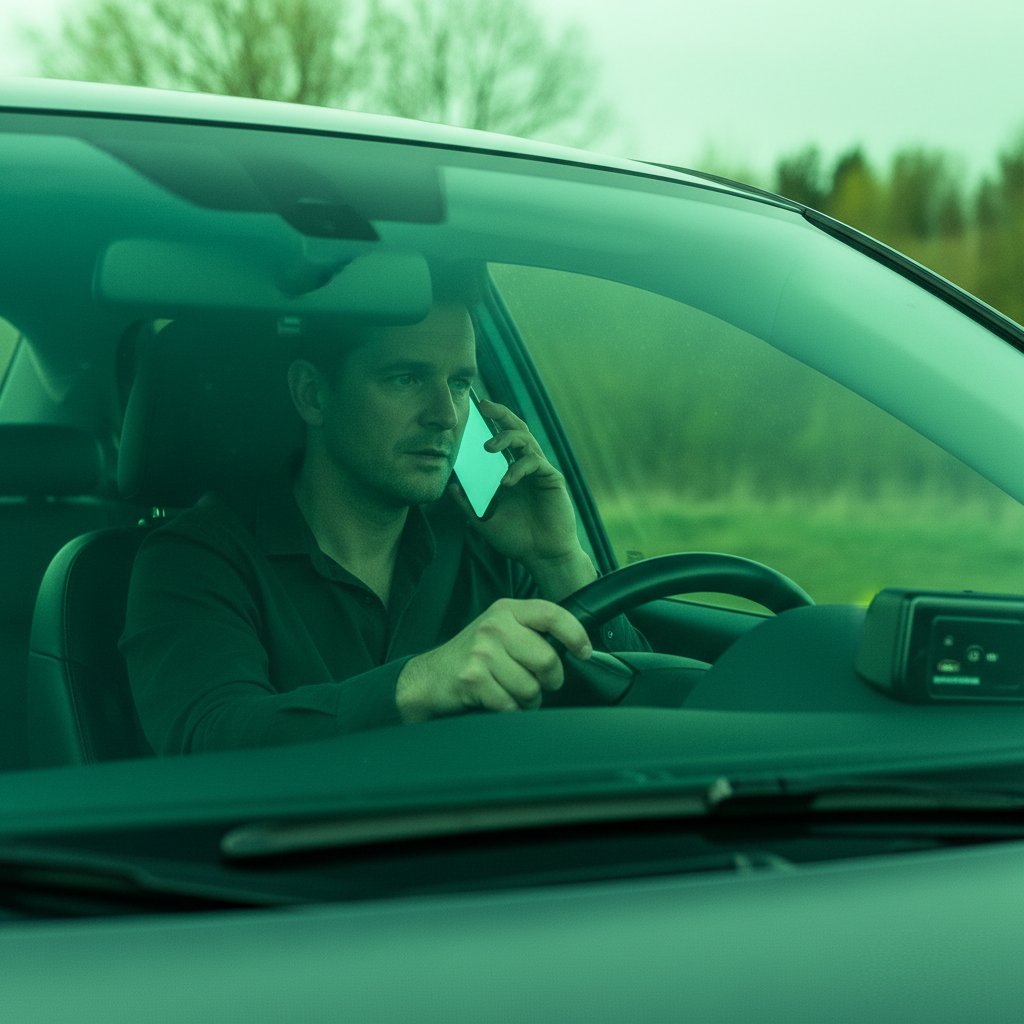Mobile Phones and Driving
Mobile Phones and Driving — The Cognitive Distraction Crisis
Extensive studies have shown that making or receiving a phone call while driving imposes a mental burden that significantly undermines safe driving. Our brain cannot give full attention to two demanding tasks at the same time — steering, observation, and reaction all require constant concentration. When we divide that focus with conversation or text communication, the risk of an accident multiplies. Talking on the phone is not merely mechanical — it is a cognitive task. It demands attention, emotional engagement, and mental effort. The driver is faced with a double challenge: managing the vehicle and maintaining the dialogue. The more complicated the traffic situation — such as navigating roundabouts, overtaking, or driving in heavy rain — the greater the interference caused by the telephone conversation.

The Cognitive Science Behind Distracted Driving
When you engage in telephone conversations while operating a vehicle, your brain faces an impossible cognitive challenge. Driving requires continuous visual scanning, situational awareness, and rapid decision-making — all demanding significant mental resources. A telephone conversation, even through hands-free systems, competes for these same limited cognitive resources, creating a dangerous division of attention where neither task receives the focus it requires for safety.
Consequences of Using a Mobile Phone Whilst Driving
- Reduced alertness and attention spread: focusing on the caller draws attention away from visual cues, mirrors, and changing road conditions.
- Fourfold increase in accident probability: Research indicates that the likelihood of a crash quadruples when the driver is on a call. During the first five minutes of conversation, the risk may rise sixfold. Frequent phone users have roughly double the fatal accident rate of occasional users, and the risk remains elevated even minutes after the call ends.
- Slower reaction times: Reaction speed may decrease by up to 50%. A half-second delay may be the difference between avoiding or causing a collision.
- Poor lane discipline: Drivers may drift out of lane or misjudge the position of their vehicle, particularly on curved or narrow roads.
- Failure to decode and remember signs: Concentration lapses lead to missed speed limits, ignored “Give Way” and “Stop” signs, or overlooked temporary warnings.
- Neglecting right-of-way rules: Phone-distracted drivers often disregard yielding obligations at junctions or roundabouts, endangering others.
- Unsafe following distances: Maintaining adequate separation becomes inconsistent. Drivers may fail to adapt when the vehicle ahead slows or stops.
- Incomplete signalling: Drivers might forget to indicate when changing lanes or turning, leaving others unaware of their intentions.
- Speed misjudgement: Many assume they slow down during calls; in reality, most maintain or even slightly increase speed due to distraction.
- Reduced visual field: Phone use narrows peripheral vision. Eye movements become fixed straight ahead, and use of mirrors declines. The road effectively becomes a small “screen”, mixing partial images of the environment, the caller’s voice, and the topic of discussion.
- Failure to yield to pedestrians: Around three-quarters of phone-using drivers fail to stop at pedestrian crossings, often unaware of people attempting to cross.
- Increased stress: Even a short or emotional call can elevate stress and heart rate, further reducing driving control and decision-making quality.
Evidence-Based Risk Analysis
Comprehensive research demonstrates that the cognitive distraction of conversation itself represents the fundamental safety problem. The human brain lacks the capacity to efficiently divide attention between the complex task of driving and engaging in meaningful dialogue. While hands-free systems improve physical vehicle control, they provide no meaningful reduction in the mental load of conversation. The impairment levels observed during phone use bear concerning similarities to low-to-moderate alcohol intoxication in terms of cognitive impact.
Practical Safety Protocol
- Implement Pre-Drive Preparation — Activate "Do Not Disturb While Driving" modes and complete all navigation setup before commencing your journey to minimize in-transit phone interactions.
- Establish Safe Stopping Protocols — If you must make or receive calls, commit to stopping only in designated safe locations rather than attempting to manage communications while driving.
- Manage Conversation Complexity — Avoid engaging in complex, emotional, or demanding conversations during driving, particularly in challenging traffic conditions or unfamiliar routes.
- Utilize Passenger Assistance — When travelling with companions, delegate communication responsibilities to avoid the driver needing to interact with mobile devices.
- Recognize Cognitive Limitations — Understand that hands-free systems only address manual distraction while leaving the more dangerous cognitive distraction unaffected.
Legal Framework and Technical Considerations
Most jurisdictions, including Portugal and the UK, have established clear legal restrictions regarding mobile device use while driving. These typically prohibit activities that compromise driving safety, including handling phones and using systems that interfere with enforcement technologies. Drivers should maintain awareness of local regulations governing hands-free use, potential vehicle electronic interference, and specific exceptions for instructional or emergency situations.
Portuguese law strictly regulates mobile phone use and electronic devices in vehicles:
Prohibited: Using handheld mobile phones, headphones, or any device that requires handling while driving. Installing equipment that detects or interferes with traffic enforcement systems.
Permitted (with conditions): Single earpiece systems, integrated loudspeaker systems that don't require continuous handling, and equipment used during driving instruction.
| Situation | Risk Level | Safe Action |
|---|---|---|
| Incoming call while driving | High | Let it go to voicemail |
| Need to make urgent call | High | Find safe place to stop |
| Using hands-free kit | Medium-High | Keep conversations brief and simple |
| Texting or reading messages | Extreme | Never attempt while driving |

